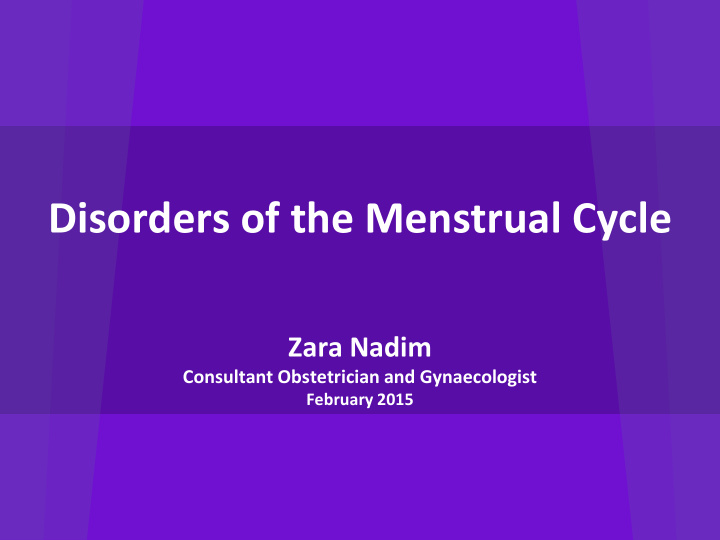



Disorders of the Menstrual Cycle Zara Nadim Consultant Obstetrician and Gynaecologist February 2015
Background Menstrual Disorders 1 in 20 women aged 30-49 present to their GPs with • this disorder per year. £7 Million per year spent on primary care prescription • One of the most common reason for specialist referral • Account for a third of gynae outpatients workload •
Physiology of the Menstrual Cycle
Disorders of the Menstrual Cycle • Menorrhagia Excessive uterine bleeding (>80ml) Prolonged (>7 days) regular • DUB Abnormal Bleeding, no obvious organic cause usually anovulatory • Oligomenorrhea Uterine bleeding occurring at intervals between 35 days and 6 months • Amenorrhea No menses x at least 6 months
Disorders of the Menstrual Cycle • Anovulatory – Oligo or Amenorrhea +/- Menorrhagia • Ovulatory – Regular menstrual cycles (plus premenstrual symptoms such as dysmenorrhea and mastalgia
Dysfunctional Uterine Bleeding DUB Excessively heavy, prolonged or frequent bleeding of uterine origin that is not due to pregnancy, pelvic or systemic disease -Diagnosis of exclusion - Anovulatory -Usually extremes of reproductive life and in pts with PCOS
DUB Pathophysiology • Disturbance in the HPO axis thus changes in length of menstrual cycle • No progesterone withdrawal from an estrogen-primed endometrium • Endometrium builds up with erratic bleeding as it breaks down • Spiral arteries do not develop properly and are unable to undergo vasoconstriction at the time of shedding.
DUB Management ● Clinical examination ○ General appearance (? Pallor) ○ Abdominal examination (?Pelvic mass) ○ Speculum examination ● Assess vulva, vagina and cervix ○ Bimanual examination ● Elicit tenderness ● Elicit uterine / adnexal masses
DUB Management ● Indicated if age > 40 years ● or failed medical treatment ○ FBC / Coagulation screen (Von Willebrand Disease) ■ The most common inherited bleeding disorders; prevalence 0.6- 1.3%’ ■ The overall prevalence is even greater among women with chronic heavy menstrual bleeding, and ranges from 5% to 24%, more prevalent among Caucasians (15.9%) than African. ○ Thyroid function (only if clinically indicated)
DUB Management • Smear/endocervical swabs/High vaginal swabs • Pelvic ultrasound scan (TV scan) • Hysteroscopy • Endometrial biopsy
Hysteroscopy
Menorrhagia • Heavy vaginal bleeding that is not DUB Usually secondary to distortion of uterine cavity • • Uterus unable to contract down on open venous sinuses in the zona basalis Other causes organic, endocrinologic, hemostatic and • iatrogenic Usually ovulatory •
Simple Endometrial Hyperplasia
Complex Endometrial Hyperplasia
Causes of HMB
Endometrial Evaluation Endometrial Sensitivity -91% Well tolerated, anesthesia Biopsy and cervical dilation usually False positive rate -2% not required Transvaginal Sensitivity -88% Good visualization of Ultrasound fibroids; may fail to identify (TVS) other intracavitary abnormalities like polyps Hysteroscopy Sensitivity -100% Gold standard perimenopausal women.
Menorrhagia- Medical Management • NSAID’s – 1 st line, for days of heavy mens loss, decrease prostaglandins • OCP’s – esp. if contraception desired, up to 60% dec. suppress HP axis • Continuous OCP’s • Oral continuous progestins (day 5 to 26) – anti-oestrogen, downregulates endormetrium • Levonorgestrel IUD (Mirena), High satisfaction rate
Menorrhagia - Surgical Management Ablation UAE Myomectomy Surgical Hysteroscopy TCRF/polypect Hysterectomy omy
Menorrhagia - Management Summary • Tailor treatment to individual patient • Consider patients age, coexisting medical diseases, desire for fertility and adverse effects • Surgical management reserved for organic causes (e.g fibroids) or when medical management fails to alleviate symptoms
Primary Amenorrhea • Absence of menses by age 14 with absence of SSC (e.g. breast development) or absence by age 16 with normal SSC • Only 3 conditions unique to primary, other causes of amenorrhea can cause either • Imperforated hymen • Vaginal agenesis • Androgen insensitivity syndrome • Turners syndrome (45, X0)
Amenorrhea • Generalized pubertal delay – e.g. Turner syndrome • Normal puberty – e.g. PCOS • Abnormalities of the genital tract – e.g. Asherman’s syndrome
Amenorrhea - Management • History is probably the most important aspects in diagnosis • Remember to always rule out pregnancy • Ovarian-axis problem- TSH, prolactin, FSH, LH • Hirsuitism-Testosterone, DHEAS, androstenedione and 17-OH progesterone • Chronic ds.- ESR, LFT’s, cr and U&Es
Postmenopausal bleeding
PMB – Exclude malignancy ● History and assessment of risk factors ○ Use of HRT / Tamoxifen / BMI ● Clinical Examination ○ R/O cervical carcinoma ● Trans-vaginal USS ○ Assessment of endometrial thickness (<3mm) ● Endometrial sampling (+/- uterine evaluation) ● Treatment for endometrial Cancer ○ Hysterectomy +/- radiotherapy
Endometrial Carcinoma ● Type I ○ Oestrogen dependent ○ 80% ○ Low grade ○ Assoc with obesity (40%), nulliparity, late menopause, tamoxifen ● Type II ○ Non-oestrogen dependent ○ Older postmenopausal women ○ High grade ○ Serous, clear cell and mixed histology ○ Tamoxifen; no association with hyperoestrogenism or hyperplasia ○ Aggressive behaviour
Endometrial Carcinoma Prognostic Factors ● Histological type ● Histological grade ● Depth of myometrial invasion ● Lymphovascular space invasion ● FIGO stage
Case 1 ● 38 year old, para 2 + 0, company executive ● Presenting complaint ○ excessive menstrual blood loss ○ requirement for contraception ● History ○ Menarche aged 13 years ○ Used OC pill until 28 years ○ Smokes 15 / day ● Examination ○ Normal sized uterus and normal adnexae
Case 2 ● 42 year old, para 0 + 0, primary school teacher ● Presenting complaint ○ excessive menstrual blood loss and dysmenorrhoea ● History ○ Menarche aged 12 years ○ Used OC pill until 32 years ○ Currently using tranexamic acid with unsatisfactory effect ● Examination ○ Uterus appears enlarged to 18/40 size
Case 3 ● 59 year old, para 0 + 0, retired ● Presenting complaint ○ vaginal bleeding on two occasions over last 3 months ● History ○ Menopause aged 49 years ○ Polycystic ovarian syndrome ○ Infertility ○ BMI = 38 / Overweight for many years
Thank You
Recommend
More recommend